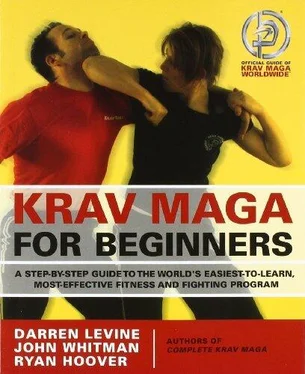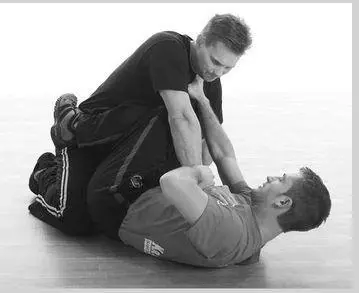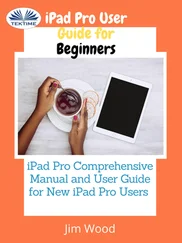There are a number of guard escapes, including stacking and passing the guard, but again, this book focuses on the basics. The simplest way to escape the guard is to sit back and strike the groin.
Starting position:The attacker holds you close so that you cannot strike effectively.
1Use eye gouges, scratching, and biting to create distance.
2Sit up, keep your back straight, and strike down to the groin.
3When the attacker pulls his knees in to protect his groin, sit back further, putting your hands on his legs to prevent him from kicking you.
4Stand up and back up to create distance.
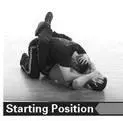
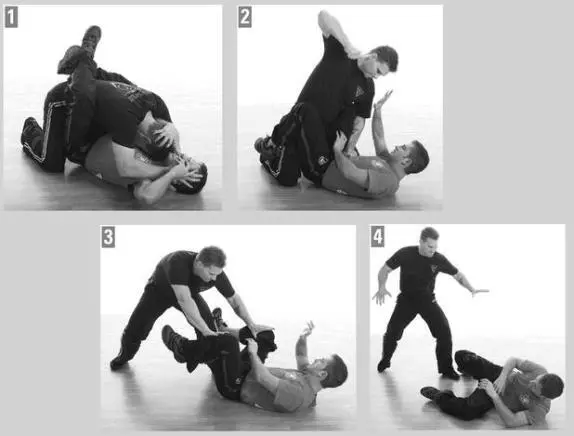
Training Tips:Whether the attacker holds you in close or not, he has two basic choices for a guard position. You have two guard positions to choose from: closed guard and open guard.
If the attacker chooses an open guard, you should be able to sit back, create distance, and get away.
If the attacker chooses a closed guard, his crossed ankles will prevent you from simply sliding away from him. However, if his ankles are crossed, his groin will be exposed. Strike hard to the groin, which will usually cause him to open his guard and bring his knees in to protect his groin. At this point, you can get up and away.
Dealing with the Full Mount
Earlier, we discussed how to maintain our position when we’re in the full mount. Now, we must defend ourselves when the attacker is on top of us. There are two basic ways to deal with this situation.
Starting position:The attacker has you in full mount.
1Dig your elbows into his thighs and keep your hands up to protect your face. Pull your feet up close to your butt. Your goal is to keep the attacker low on your hips, where your movements will affect him. Do not let the attacker scoot up onto your chest with his knees under your armpits. This makes everything much more difficult for you: your arms become trapped, and your hip action does not affect him at all.
If the attacker does manage to scoot up, try jamming your elbows into his thighs and wriggling upward so that he ends up back down near your hips.
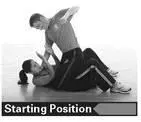

Training Tips:In general from the position, do not extend your arms upward. This exposes them to several types of submission-style attacks, such as an arm bar. Keep your elbows bent and close to you.
Defending against Strikes
The basic principles for defending against strikes are the same here as when standing.
Keep your chin tucked and your head off the ground. You should use Inside Defenses and 360° Defenses to block straight punches and outside attacks such as hook punches. If the attacker uses an elbow, you may need to defend it with two arms rather than one.
In addition, buck your hips. Every time the attacker tries to throw a punch, buck your hips to disturb his balance. At the very least, you’ll weaken his punch. At most, you may cause him to base out so that he cannot punch until he recovers.
Training Tips:Try a basic drill where your partner sits in full mount and tries to punch. Every time he punches, buck your hips. Try to time the hip action so that it coincides with the beginning of the punch for maximum affect. This is harder to do during a real fight, but it’s a great drill to develop awareness in this position.
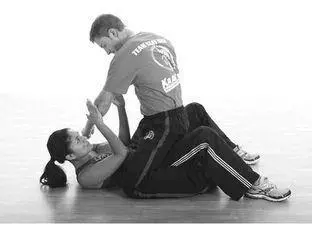
Inside defense
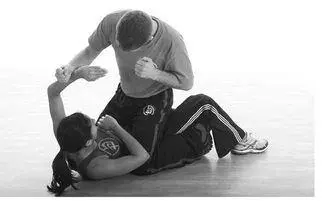
360° defense
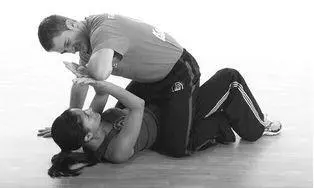
Defend an elbow strike with two arms.
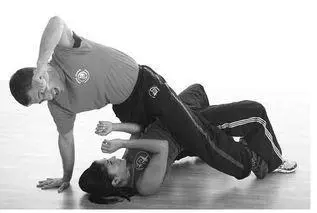
Buck your hips to upset attacker’s balance.
Starting position:The attacker has you in full mount.
1Buck your hips to make the attacker base out.
2-3With one arm, reach out to trap one of his arms. You can reach either over (trapping from the inside out) or under (trapping from the outside in). Generally, reaching over the arm makes for a better hold but may take longer to execute. Be sure that you trap the arm above the elbow so that he cannot slide his elbow out.
4Using your leg, trap the attacker’s leg on the same side as the arm—as much as possible at the same time as you trap the arm. Buck your hips again, driving upward toward your head.

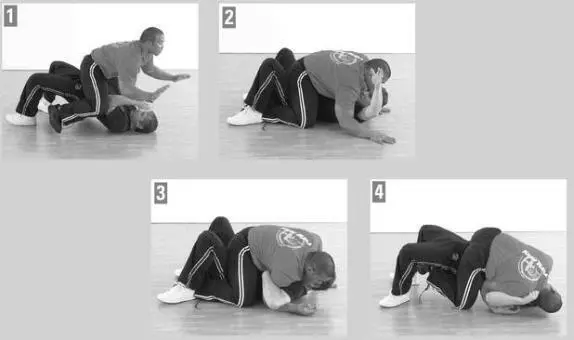
5-7At the end of this motion, roll your hips over toward the trapped side. Drive over with your feet to end up on top, striking as you go. Your goal should be to deliver an elbow to the face, but if the attacker’s resistance makes that impossible, deliver groin strikes.

Training Tips:When you buck your hips (also called bridging), do it explosively. You do not want to give the attacker time to react or adjust. Also, do NOT roll sideways. Buck your hips toward your head, then roll the attacker over your shoulder. Rolling sideways will not give you the same power or degree of movement.
When trapping the arm, there are a variety of alternatives. We have described two here, but in the end, trap the arm any way you can. If the attacker is wearing thick clothing, you can reach up and grab his clothes, pulling his arm in close. If he is holding his hand in the air, reach up and grab that hand with your two hands. The method of trapping is not important, so long as you trap his arm effectively!
Trapping his arm prevents him from “posting” that hand out when you try to roll him over. If he is able to post his arm out, he will stop you from rolling and you will end up back where you started.
Finally, be aware that you are in a difficult position. It may take several attempts to successfully trap his arm. Do not panic, but do not give up, either. Every time he tries to strike you, buck your hips. At the very least, you will affect his balance and make it harder for him to strike. At most, you will create another opportunity for the trap and roll.
Читать дальше
